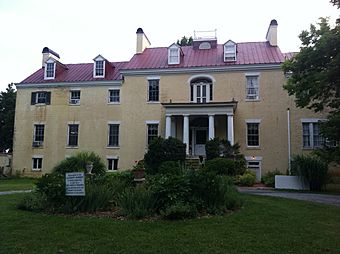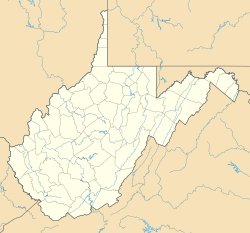Claymont Court facts for kids
Quick facts for kids |
|
|
Claymont
|
|

Front entrance to Claymont Court
|
|
| Nearest city | Charles Town, West Virginia |
|---|---|
| Built | 1840 |
| Architectural style | Georgian |
| NRHP reference No. | 73001908 |
| Added to NRHP | July 25, 1973 |
Claymont Court, often called simply Claymont, is a large Georgian-style brick house. It's one of the most impressive homes built near Charles Town, West Virginia, for members of the Washington family. The main house you see today was built in 1840 for Bushrod Corbin Washington. He was the grand-nephew of George Washington. This new house replaced an earlier one from 1820 that burned down in 1838.
In 1899, the famous author Frank Stockton bought Claymont. He lived there until he passed away in 1902. Later, in 1943, a West Virginia businessman named Robert Joseph Funkhouser purchased Claymont. He also bought two other nearby Washington family homes, Blakeley and Cedar Lawn. He combined these properties into a huge estate of about 7,000-acre (28 km2).
In 1974, John G. Bennett bought Claymont. He wanted to create a special place for people to live and learn together. Today, the Claymont Society for Continuous Education uses it as a retreat center.
Contents
Claymont's Early Days with the Washington Family
In the 1700s, the land where Claymont stands was owned by John Augustine Washington. He was George Washington's brother. George Washington himself developed the Bullskin Plantation nearby. It was the first property he ever owned.
In 1811, George Washington's grand-nephew, Bushrod Corbin Washington, inherited this land. He was 21 years old. With the labor of about 90 enslaved people, he built a huge thirty-four room house there. Bushrod's brother, John Augustine Washington III, later built the Blakeley mansion very close by. The two brothers married sisters from the Blackburn family. They started their families in these two grand homes, facing each other.
Bushrod finished building Claymont in 1820. It cost $30,000, which was a huge amount of money back then. People even called the house "Bushrod's folly." Once it was finished, it was the biggest house in the area. With later additions, it grew to 16,000 square feet (1,500 m2) with 59 rooms and 25 fireplaces. This made it the largest house in West Virginia. Claymont also showed the "Virginia Plantation Style" of building. It had extra wings, courtyards, and separate buildings for different uses. Sadly, Claymont burned down in 1838. Bushrod had just started his first week as a representative in Richmond. People believe the fire started in the basement kitchen's fireplace.
The main part of the house was completely rebuilt in 1840. The rest of the house was also repaired. Bushrod passed away in 1851. He left Claymont to his son, Thomas Blackburn Washington. Thomas died in 1854, and his oldest son, Bushrod Corbin Washington II, inherited the estate.
Claymont During the Civil War
The American Civil War was very hard for the Washington family. Many family members found safety at Claymont during the war. Two young men from the house, including Thomas Blackburn Washington's youngest son James, became officers. They fought for the Confederate Army under John S. Mosby. He was known for leading raids.
Both young men were captured at Claymont Court during their Christmas holiday leave. Union Army troops led by George Armstrong Custer caught them. Interestingly, Custer had been a roommate of one of the Washington men. They were both students at the West Point military academy. The Washington men were taken to a Union prison camp. Sadly, they both died there. These camps often had many diseases because they were crowded and not clean.
As a punishment to Claymont for "helping guerrilla fighters," General Sheridan gave an order. All the cattle were taken from the land, except for one milk cow. Also, every fence around the Clay Mound farm was burned down.
After the Civil War, the government during the Reconstruction period asked for back taxes. These were for all the years the Washington family had paid taxes to the Confederacy instead of the Union. Like many families, the Washingtons didn't have much money. They were also struggling because farming was not doing well. They couldn't pay the taxes. By 1871, the family had to sell Claymont for only $10,000. This was much less than it cost to build. Most of the family then moved to the Pacific Northwest. They settled in the territory of Washington, which became a state later in 1889.
After the Washington family left, Claymont was owned by different people. The house and land were empty for some years at a time. This caused the property to start falling apart because it wasn't being cared for. The farming also stopped. Claymont used to be a self-sufficient farm. This means it produced almost everything the people living there needed. Before the Civil War, the owners had nearly one hundred enslaved people. They also had a few dozen free workers to do all the work.
Because Claymont was so big, it cost a lot to keep it running. It became harder to make enough money to keep the estate going. This was especially true when they started using only free workers. Also, farming markets were declining for many years.
Later Owners of Claymont
After the Washingtons sold Claymont, several different people owned the property:
- 1871-1886: Clement March
- 1886-1889: Charles Dawson
- Dawson hired William A. Bates, an architect from New York City. Bates redesigned the house and made it much bigger. The ballroom and dining room wings were made larger. A second floor was added to both wings. This included more bedrooms and bathrooms.
- 1889-1906: Frank R. Stockton
- Stockton was a very popular author back then. He wrote three books while living at Claymont. He is most famous for his short story "The Lady, or the Tiger?".
- 1906-1943: Col. S.J. Murphy
- Murphy rebuilt and improved Claymont's old gardens. He worked with Conklyn Brothers Landscape Architects. He added a 235-foot (72 m) pergola (a garden archway) and a large fountain.
- 1943-1972: R.J. (Raymond Joseph) Funkhouser (1885-1965)
- Funkhouser was a well-known businessman in West Virginia. He owned or controlled 18 companies. He retired at age 50. He bought and restored several old Washington family homes in Jefferson County. He bought Cedar Lawn, Blakeley, and Claymont. He combined them into one 7,000-acre (28 km2) property. Funkhouser lived at Claymont. The gardens and grounds were kept in perfect condition during this time.
- 1972-1975: J. Glenn Brown
- Brown had bought Blakeley Mansion earlier. He and his family lived at Blakeley from 1954 to 1979. He sold Claymont and 418 acres of land to the Claymont Society in 1975. The sale included rules to protect the property from being developed.
- 1975–present: The Claymont Society for Continuous Education
- John G. Bennett, an English thinker and scientist, led a non-profit group. This group bought Claymont to create a community where people could live and learn together. Today, The Claymont Society for Continuous Education is still a non-profit. It focuses on learning throughout life and living in a way that helps the environment.
Claymont Today: A Retreat and Learning Center
Of the eight Washington family homes still standing in Jefferson County, Claymont is thought to be the grandest. At 16,000 square feet (1,500 m2), it is also the largest. In 1973, Claymont was added to the National Register of Historic Places. This is a U.S. government list of important buildings that should be protected.
Today, Claymont is a non-profit retreat center. It is run by The Claymont Society for Continuous Education. Its members study the ideas of John G. Bennett. When Bennett was alive, Claymont was a nine-month school. It focused on his teachings about self-reflection, self-development, and spirituality. It also taught a system called Systematics and how to live in a way that helps nature. After Bennett passed away in 1974, the nine-month course continued for a few years. But it was eventually stopped.
Claymont was then changed to be a retreat center for many different groups. These include spiritual groups, healthcare workers, meditation groups, and environmental groups. The rooms were updated with showers. Utilities like hot water, electricity, natural gas, and Wi-Fi were added. The main house is now used as the retreat center.
The non-profit group strongly focuses on organic farming. They also buy local products and practice sustainability. Claymont hosts WWOOFers. These are volunteers who work on the grounds and help with farming. In return, they get free food and a place to stay. A nearby 450-foot (140 m) cattle barn has been turned into a conference center. Much of the estate grounds are still cared for, including the lawns around the house. However, the old gardens were damaged in a storm. They are too hard to maintain now and are not used.
The Claymont Society for Continuous Education works hard to keep restoring Claymont Court. Claymont has received money for restoration from groups like the 1772 Foundation and Save America's Treasures. They also get help from the Jefferson County Commission and individual donations. The Claymont Society also works with the National Park Trust. They ask for more grants to help with preservation.
Some recent restoration work includes a completely rebuilt second-floor porch. New support beams were added for the main ballroom. New window seals and gutter systems were also installed. The house is still being restored, but it is fully working with all its utilities.
Gallery















